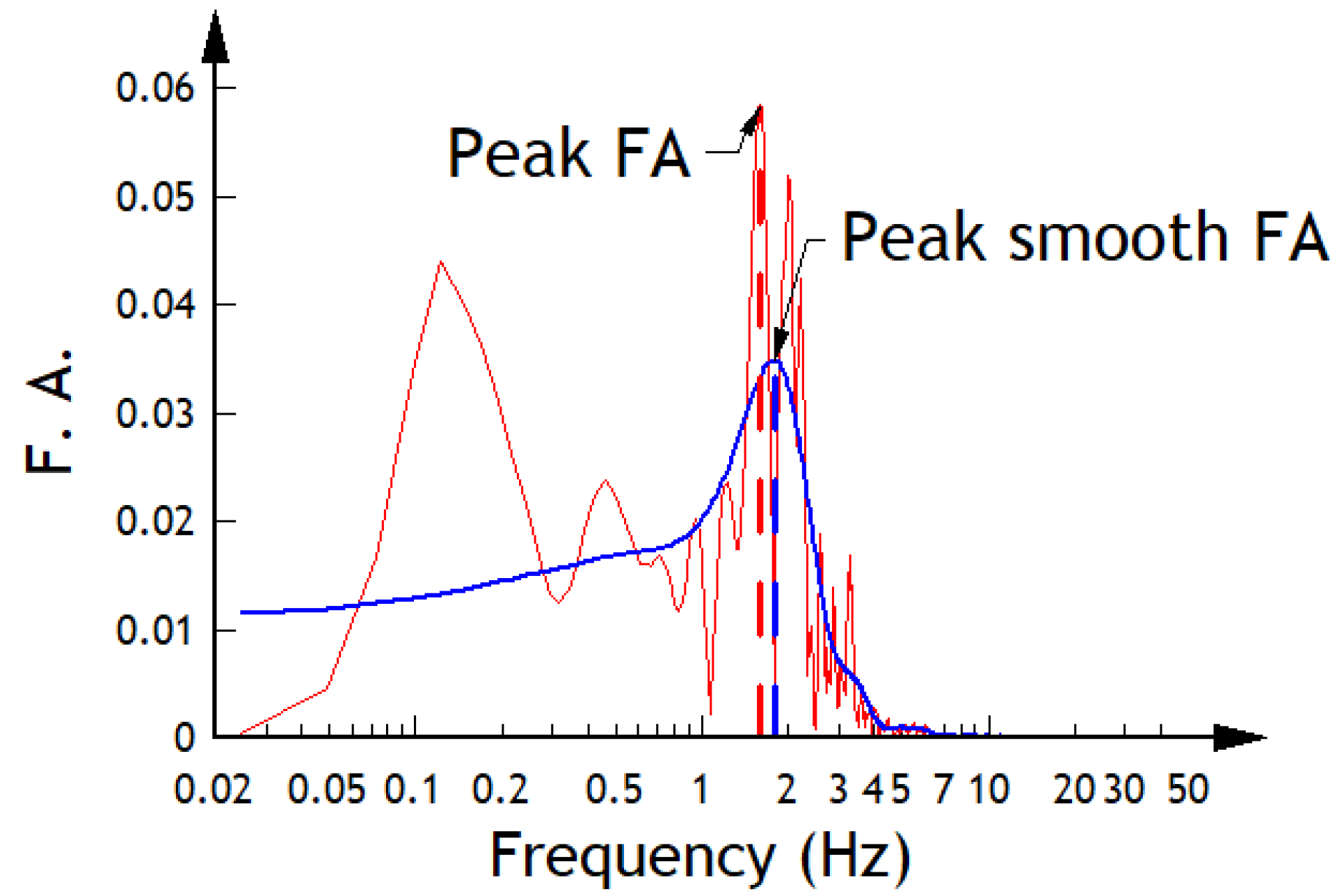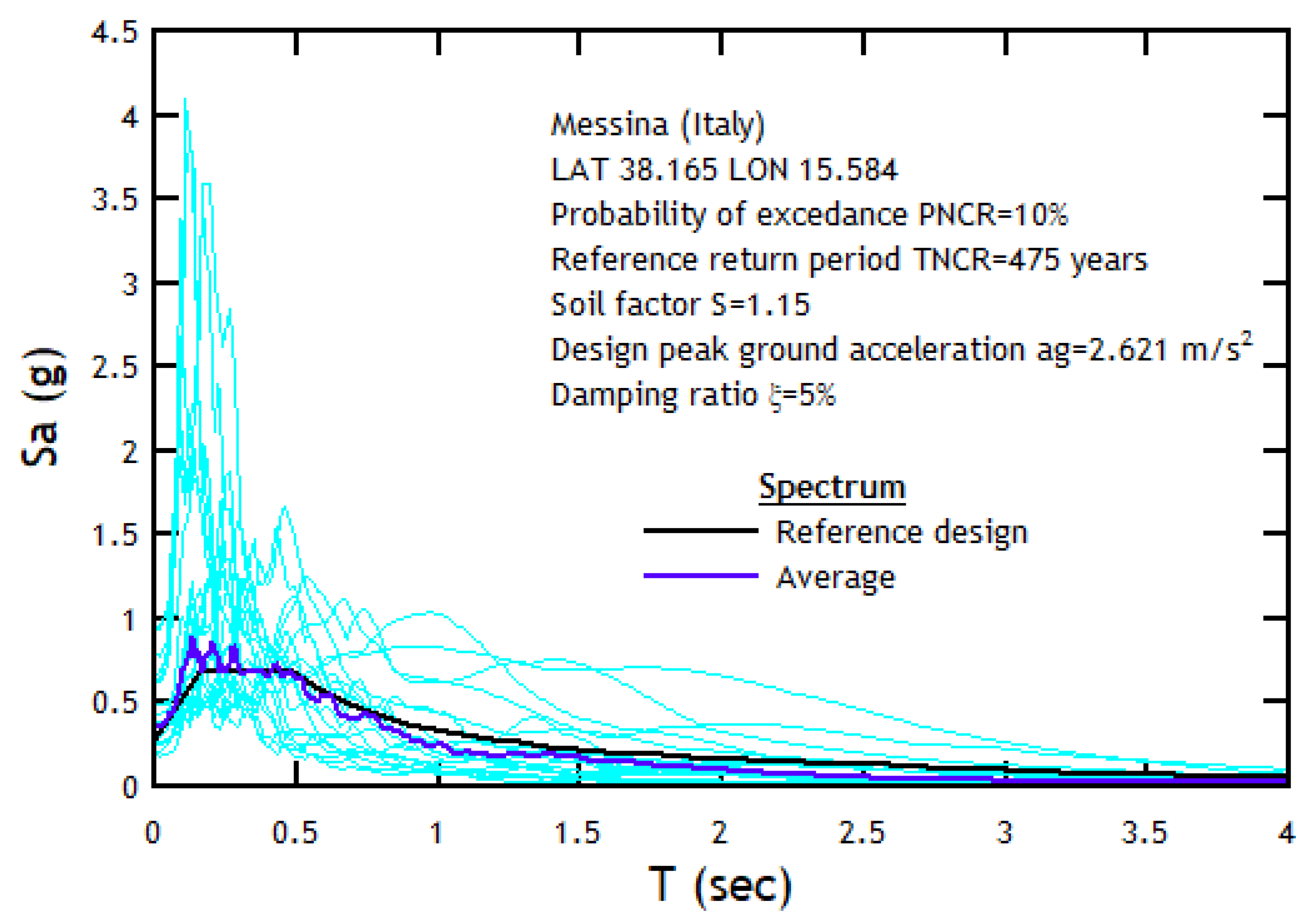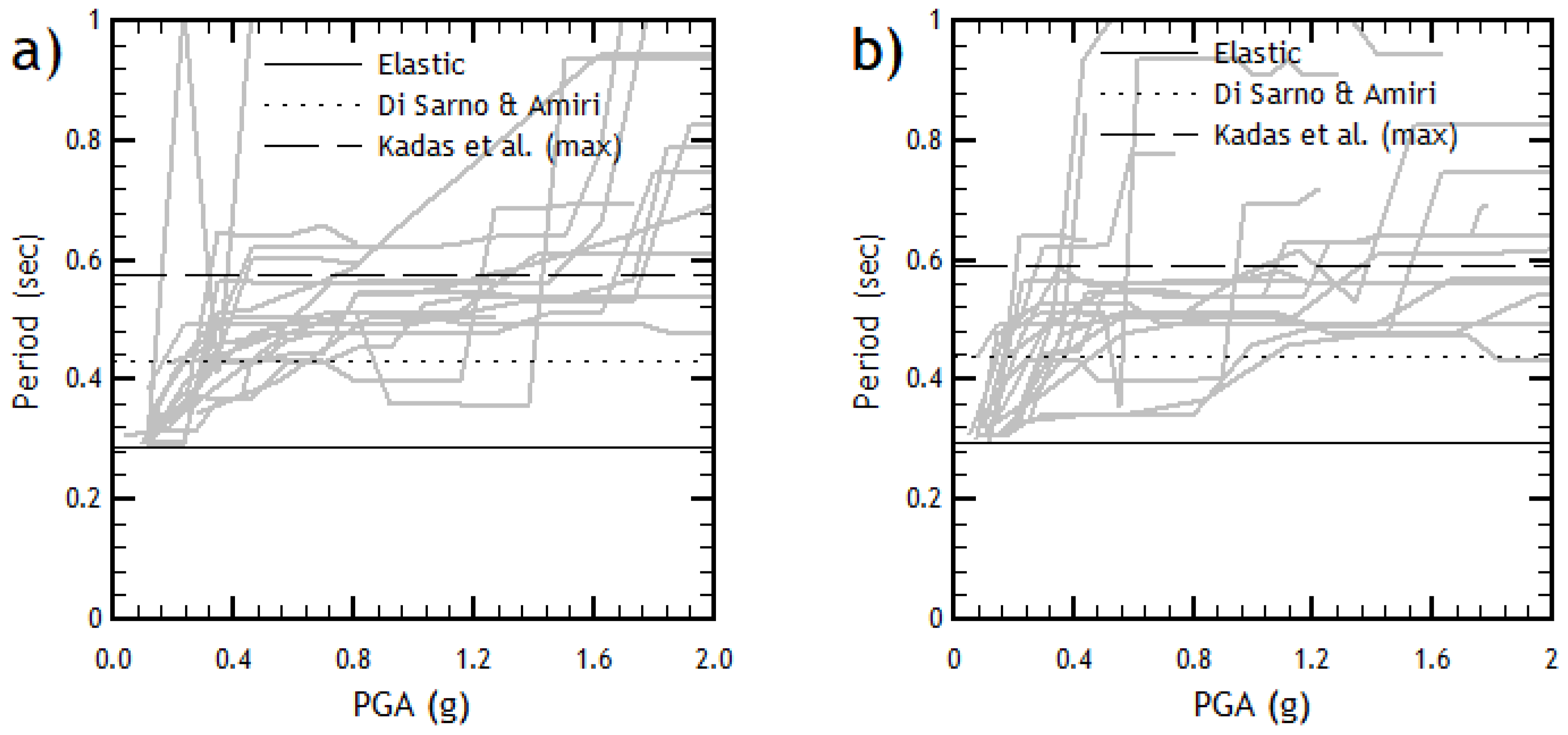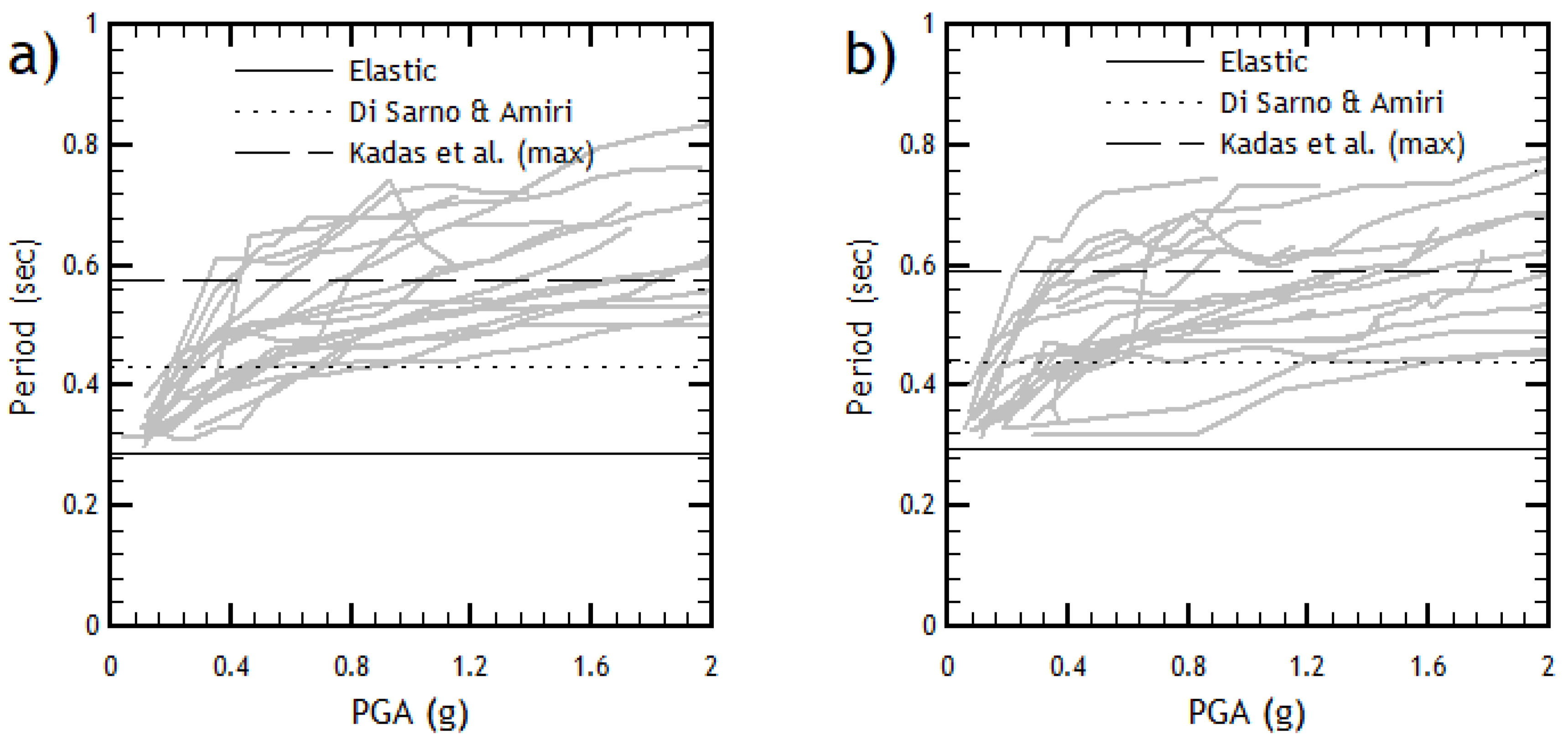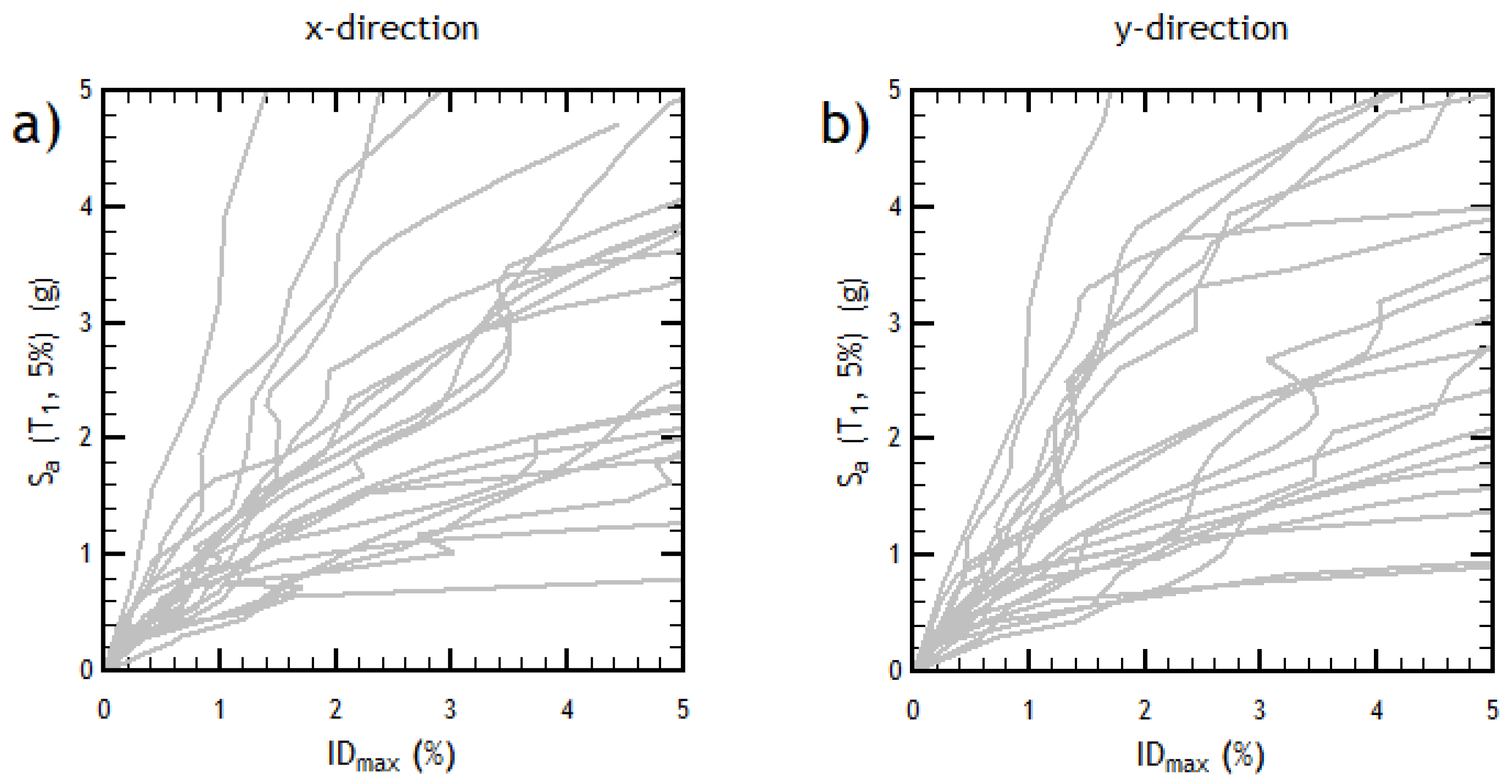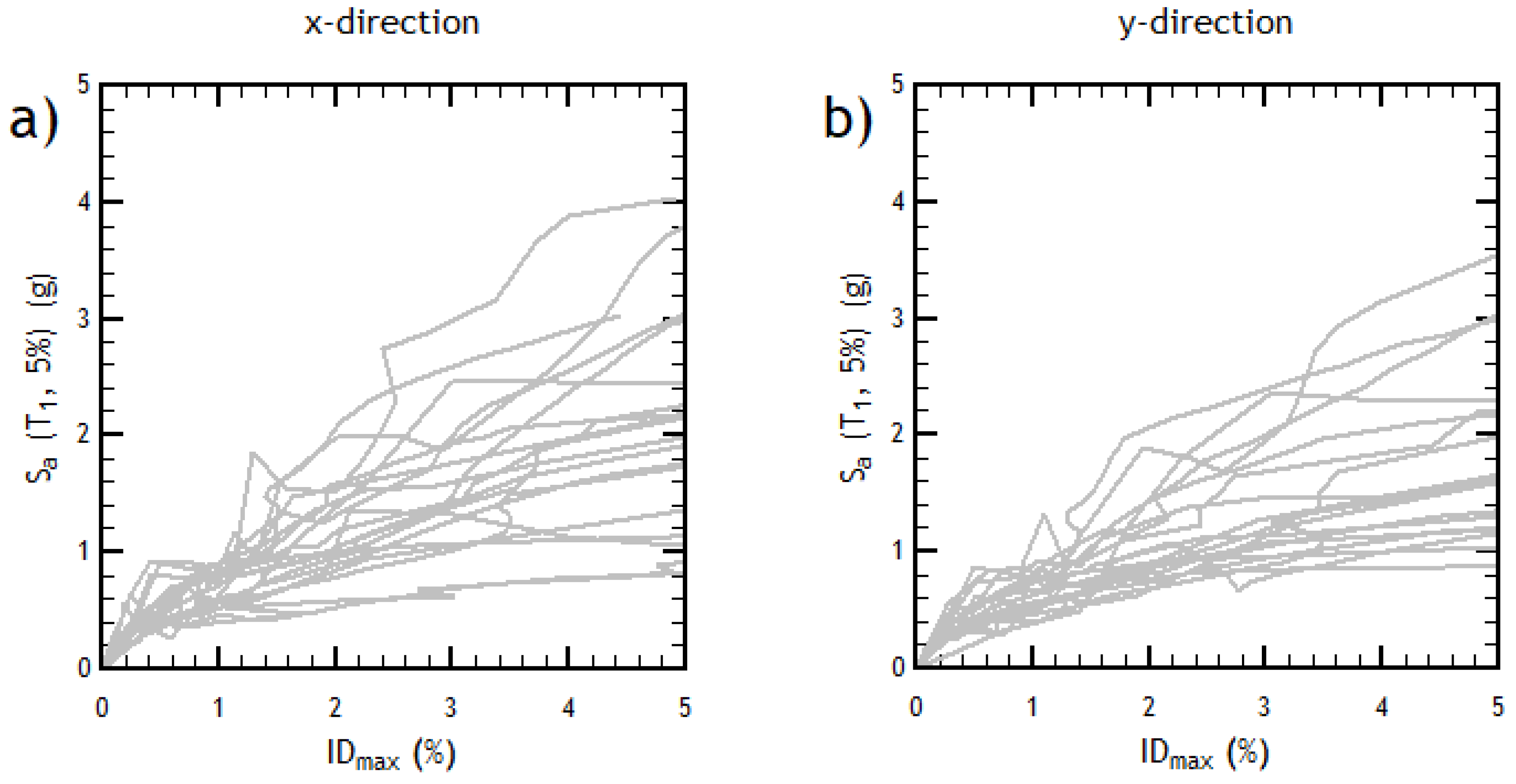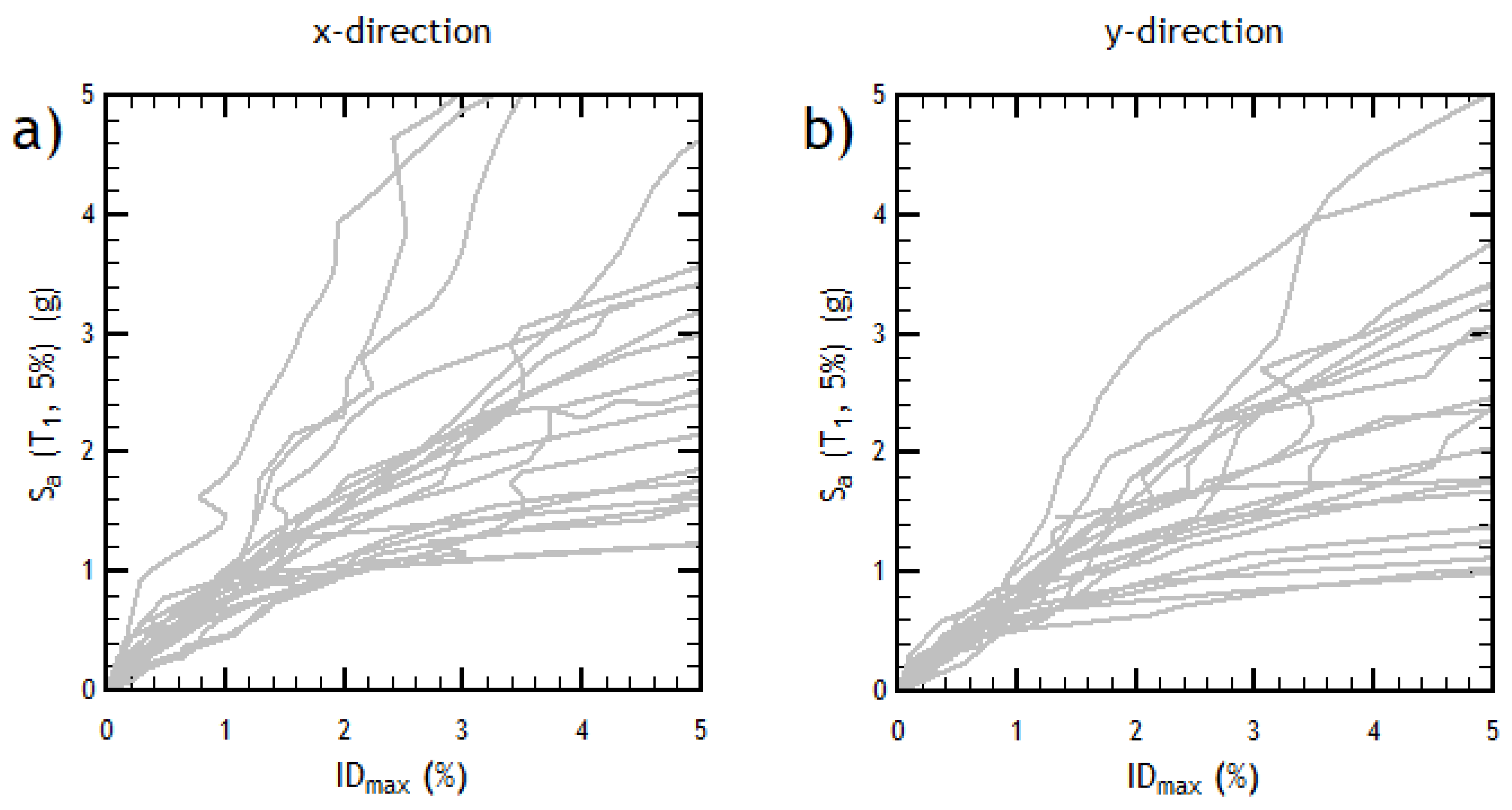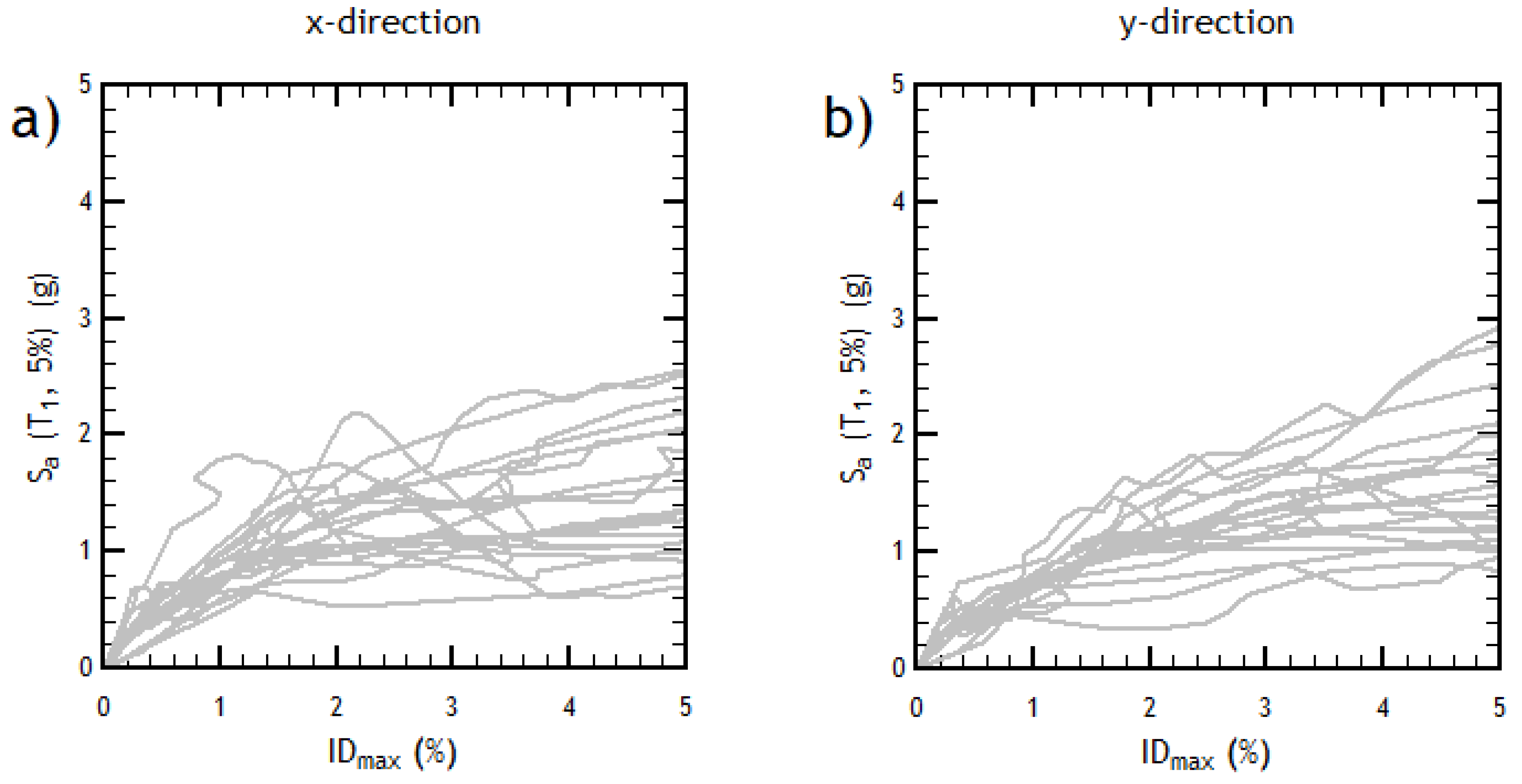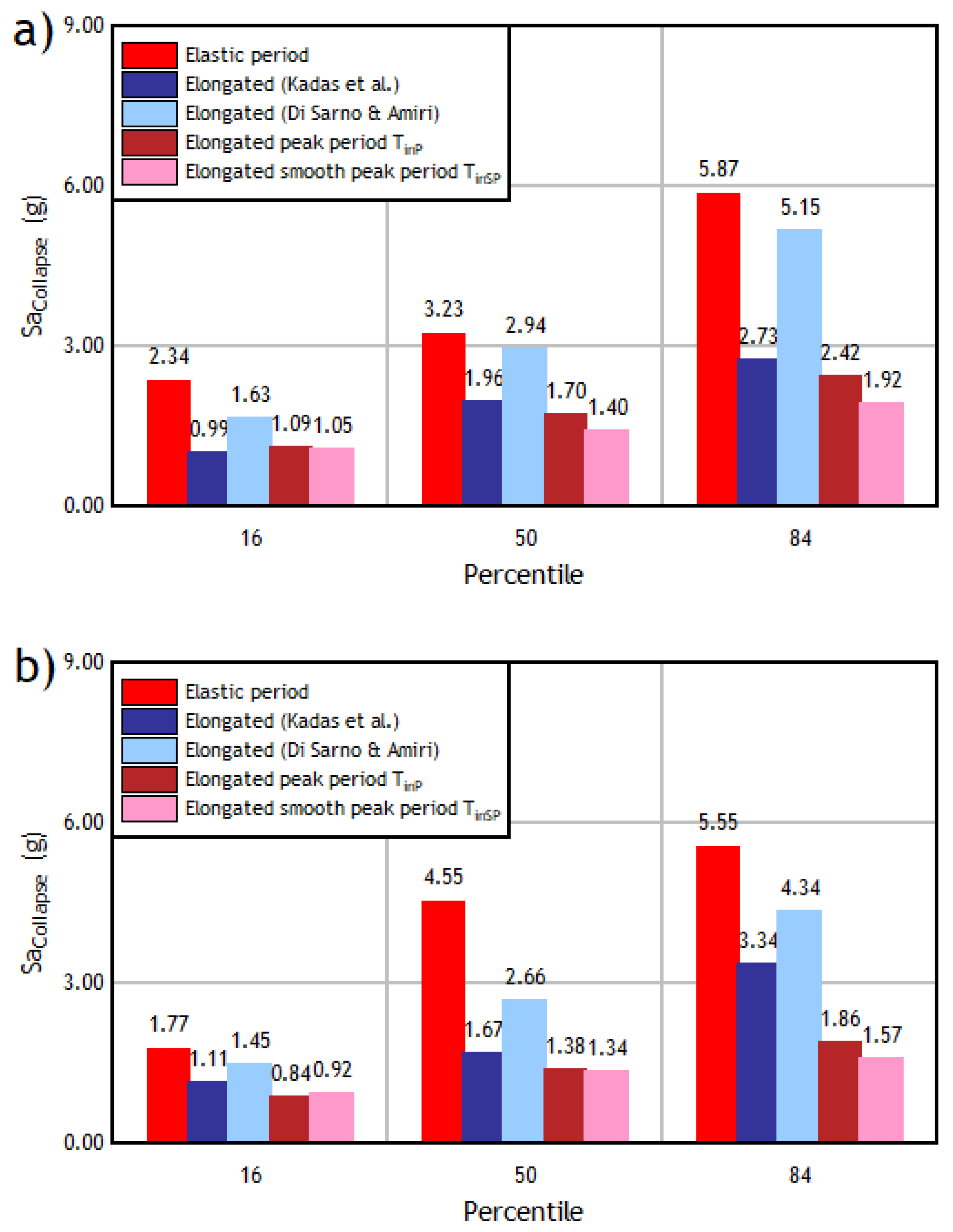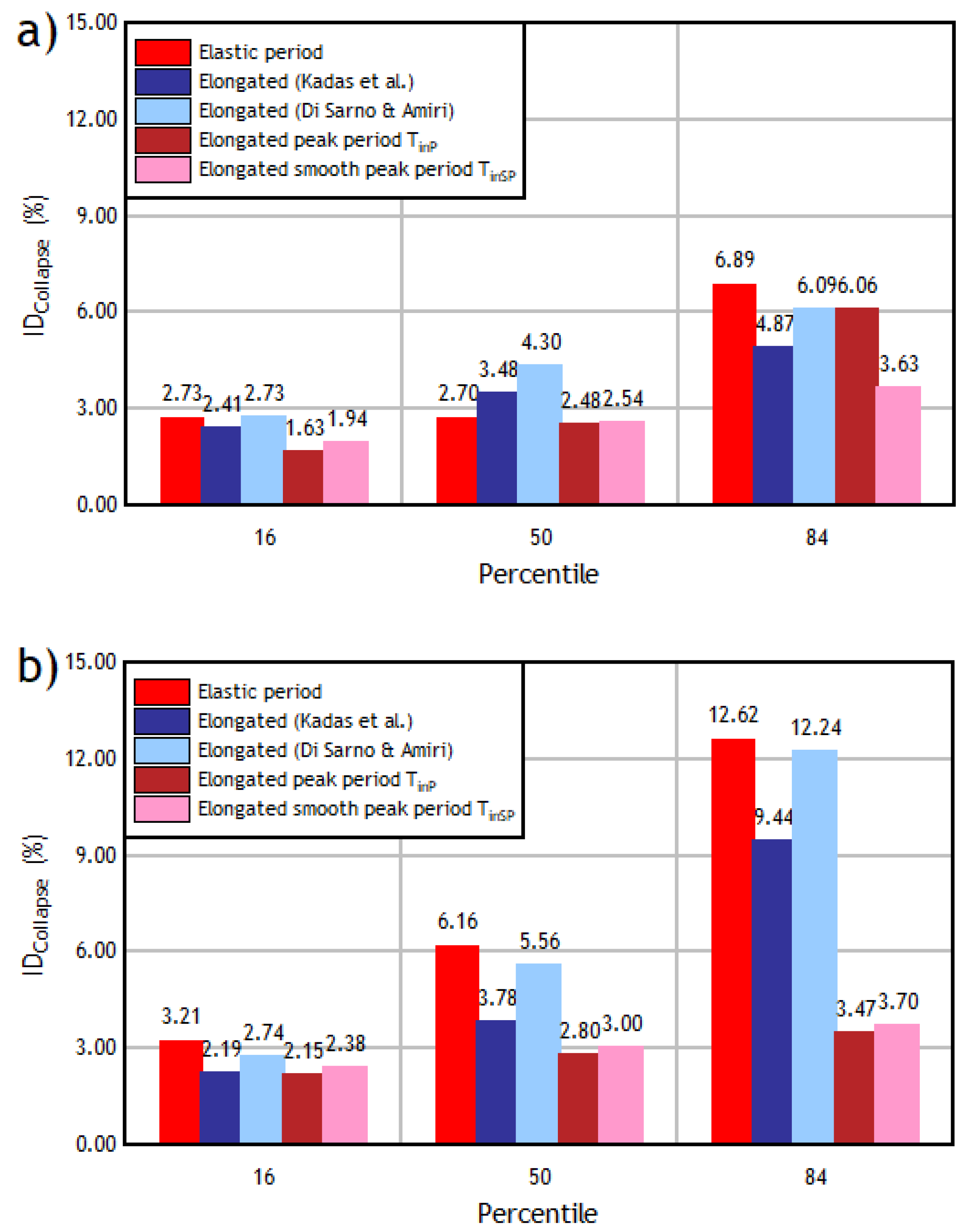Non-linear analyses are the most accurate approach for assessing the seismic behavior of civil structures, since the current codes highly encourage post-elastic dissipative behavior under strong earthquakes. Non-linear static analysis based on horizontal static loads with gradually increasing intensity (pushover analysis) is very commonly applied to ascertain the inelastic capacity of a structure until its collapse [
1,
2]. On the other hand, non-linear time-history analysis under spectrum-consistent earthquakes may be very useful for studying the evolution of the seismic demand on a given structure [
3,
4,
5]. Stemming from the concept of incremental seismic actions typical of pushover analysis, incremental dynamic analysis (IDA) is a type of non-linear analysis technique under scaled ground accelerations that is currently perceived as the most advanced tool for assessing the seismic response of structures. In the guidelines published by the Federal Emergency Management Agency (FEMA) [
6,
7], IDA is presented as the fundamental basis with which to determine the performance factors of new types of structures, as well as to obtain the collapse thresholds of existing structures while considering the variability of seismic records. Many authors have carried out IDA to obtain the performance of different kinds of new and existing structures [
8,
9,
10,
11,
12,
13,
14,
15,
16,
17]—even structures equipped with dissipation or isolation devices [
18].
1.1. Background
The unified procedure usually adopted to carry out IDA was originally formulated by Vamvatsikos and Cornell in [
19]. Their approach is based on a simple transformation of the amplitude of a reference “as-recorded” accelerogram
that is uniformly scaled up or down by a scale factor (SF), denoted
, so that
. In the elastic range, scaling the accelerogram corresponds to scaling the elastic response spectrum or, equivalently, scaling the Fourier amplitude spectrum while keeping the phase information intact.
By successively integrating the non-linear motion equations under a given earthquake, which is scaled at each iteration with a different SF, the progressive performance of a structure can be assessed from the elastic to the inelastic range until collapse. To characterize the intensity of the scaled ground motion, a parameter is adopted, namely, the intensity measure (
), which depends on the unscaled accelerogram
and increases with the SF
, that is,
[
19]. On the other hand, an engineering demand parameter, namely, the damage measure (
) should be chosen to assess the structural responses at different seismic intensity levels.
For each given accelerogram, a curve plotting the values of
as a function of
can be built. However, a single-record IDA study cannot fully capture the seismic capacity of a building. Therefore, a consistent set of records should be considered to perform a complete multi-record IDA analysis. FEMA (Federal Emergency Management Agency) codes [
6,
7] recommend the use of a group of earthquakes registered in the Pacific Earthquake Engineering Research Center (PEER) database. A group of curves can thus be obtained for multi-record IDA analysis, which is expected to give a thorough understanding of the structural demand for different intensity levels of seismic action.
Although different
values can be chosen to assess the seismic demand under earthquakes of different intensities, the maximum interstory drift ratio is widely adopted as one of the most significant parameters. In contrast, the choice of the most appropriate
value is still much debated (see, e.g., [
17,
18,
19,
20,
21,
22,
23,
24,
25]). The reason for this debate is that a suitable choice of
should account for both the seismological characteristics of the ground motion (which are typically related to the statistical properties of seismic hazard analysis) and the structural response features of the considered building (which can be estimated through the maximum values of the given target engineering parameters). However, due to record-to-record variability, comparatively high scatter in the structural responses under different reference accelerograms may affect the efficiency (the ability to predict the structural capacity independent of the selected record), the sufficiency (no other ground motion information is needed) and the scaling robustness (the ability of the SF to predict the structural response) of
[
20,
21,
22,
23,
24,
25] and, consequently, the effectiveness of the whole IDA procedure.
Several
parameters have been proposed in the literature with the aim of meeting the above requirements and reducing the dispersion of the results under different ground motions. Such parameters refer, for instance, to the peak ground acceleration (PGA), peak ground velocity, peak ground displacement, effects of the spectral shape and ground motion duration, Arias intensity, Housner intensity, spectral response, and yield reduction R-factor [
17,
18,
19,
20,
21,
22,
23]. Nevertheless, a common choice for
is the spectral acceleration taken at the structure’s first-mode period; for a damping factor
, the spectral acceleration is
). The elastic response spectrum is broadly recognized as an excellent tool to link the seismological characteristics of an earthquake to the seismic demand in single-degree-of-freedom systems.
On the other hand, assuming
) to represent
may involve some disadvantages [
19], for instance, due to (i) neglecting the contributions from higher vibration modes, (ii) lengthening of the fundamental period associated with the non-linear hysteretic behavior of the structure [
23], and (iii) the spectral shape bias occurring when using high SFs [
26,
27].
Even for structures dominated by the first vibration mode, the non-linearity of the response has crucial impacts [
23], and thus, the intensity measures based on such non-linear responses are shown to be more efficient in reducing the variability of the seismic demand [
28]. In fact, global stiffness degradation and strength reduction typically occur in reinforced concrete (R/C) buildings due to the local cracking of concrete and yielding of reinforcing bars during earthquake loading reversals; such deterioration changes the dynamic modal characteristics of the system, which can also be exploited to detect local damage during structural health monitoring [
30,
31]. Structures typically exhibit a change in the natural period when they deform widely in the plastic range, where the “inelastic” (apparent) period is usually longer than the elastic period (relevant to the undamaged structure) [
32]. In particular, the vibration period of R/C buildings was found to be highly elongated due to plastic deformation during severe ground motions (from 50 to 70% up to 100 to 130%) [
32].
1.2. Recommended Values of the “Inelastic” Period for the Earthquake Intensity Measure
The inelastic elongated fundamental period is a key parameter for establishing a rigorous evaluation of structural performance into the non-linear regime; for this reason, can represent the intensity measure required for IDA better than the elastic fundamental period . Therefore, could be evaluated by entering the earthquake response spectrum with the inelastic period instead of the elastic period .
Evaluating the lengthening of the period is still an open issue in earthquake engineering. Based on many numerical investigations, some empirical formulas have been proposed in the literature. Kadas et al. [
24] studied over 100 ground motion records and proposed the following relationship between the elastic initial period
and the inelastic final period
[
24]:
where
is the yield spectral acceleration. Note that Equation (1) limits the value of the elongated period to twice the elastic period.
To predict the value of the fundamental period shift ratio (
/
) of R/C structures, Di Sarno and Amiri [
33] provided the following formula:
The above relation produces values of
ranging from approximately
(for very rigid oscillators) to
(for flexible oscillators). Some corrective parameters are also given in [
33] to adjust the “reference” values obtained from Equation (2) to account for some deterioration effects.
By referring to one-degree-of-freedom oscillators equivalent to the considered multi-degree-of-freedom systems, Katsanos et al. [
32] derived the value of the inelastic period at the maximum amplitude of the Fourier spectrum relevant to the structural acceleration under each scaled earthquake. Both regular and irregular multi-story buildings were considered in [
32] under hundreds of recorded earthquakes, two different hysteretic rules, and 11 scaling factors (PGA reaching up to 1.7 g). The results presented by Katsanos et al. [
32] showed that the shift ratio
is typically lower than 1.7. It should be noted, however, that such results were obtained by carrying out in-plane analyses on the equivalent one-degree-of-freedom oscillators.
1.3. Basic Assumptions and Purposes of the Study
The present paper proposes to evaluate the intensity of a scaled ground motion by referring to the earthquake spectral acceleration taken at the inelastic elongated period, the latter being obtained from a time-history analysis. Two different methods are proposed to derive the elongated period. The first approach derives an inelastic peak period from the Fourier amplitude spectrum of the acceleration of a building’s reference point; the second method obtains an inelastic smooth peak period from the smooth Fourier spectrum derived from the original spectrum by applying a suitable filtering technique.
In practice, the parameter is calculated by means of the spectral acceleration (for a dampening factor ) taken at the structure’s elongated period instead of the elastic fundamental period . The value of is derived from the Fourier amplitude spectrum (obtained through the fast Fourier transform) relevant to the structural acceleration taken at the center of gravity of the building’s roof.
Two alternative strategies will be adopted to obtain the elongated period. The first strategy derives the value of
from the predominant frequency
taken at the peak amplitude of the Fourier spectrum (red diagram in
Figure 1). This period will hereafter be referred to as the “inelastic peak period”. The following formula is thus considered to obtain the value of
in this case:
It should be observed, however, that the higher the scale factor of the input record, the more difficult it may be selecting with confidence the right value of the predominant frequency
from the Fourier amplitude spectrum, due to the several peaks that may occur in the range where the predominant frequency falls (see
Figure 1). This was found to lead to the inconsistency of the values of a period that does not coherently elongate as the intensity of the scaled ground motion increases, as shown in the following sections. Therefore, a second strategy to obtain the elongated period has been considered. It is based on a smooth Fourier amplitude curve derived from the original Fourier spectrum by applying a suitable filtering technique (blue curve in
Figure 1). The value of the predominant frequency
is taken at the curve peak of the smooth Fourier spectrum, and the elongated period
is obtained accordingly. This period will hereafter be referred to as the “inelastic smooth peak period”. By referring to
, the value of
can be obtained as follows:
In the present study, the smooth Fourier spectrum has been obtained by applying an appropriate “smoothing window” in the range 0–25 Hz, which is the range where the fundamental frequencies of buildings typically fall. The smoothing window
is determined according to:
where,
is the cut-off frequency of the window while
is the time step of the acceleration record.
The aim of this paper is to assess whether and to what extent the adoption of either the intensity measure introduced in Equation (3) or that in Equation (4) can lead to an improvement of the IDA procedure, by reducing the dispersion of curves and improving the reliability of the results compared to other literature methods. For this purpose, the results of an extensive numerical investigation are presented to compare the IDA curves derived by entering the response spectrum with different values of the period: the elastic fundamental period; two values of the inelastic period, namely those in Equations (1) and (2); and the two values of the inelastic elongated period, namely and , proposed in this paper.
